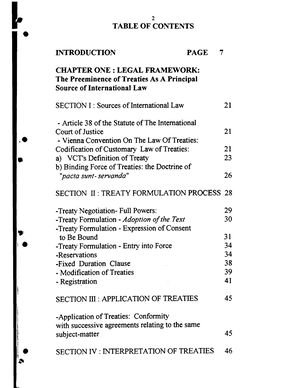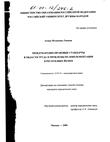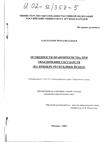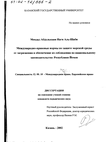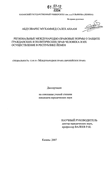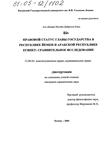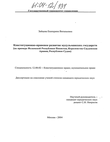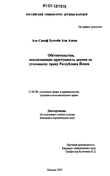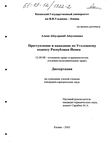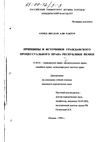Содержание к диссертации
INTRODUCTION PAGE 7
CHAPTER ONE : LEGAL FRAMEWORK: The Preeminence of Treaties As A Principal Source of International Law SECTION I: Sources of International Law 21
- Article 38 of the Statute of The International Court of Justice 21
- Vienna Convention On The Law Of Treaties: Codification of Customary Law of Treaties: 21
a) VCT's Definition of Treaty 23
b) Binding Force of Treaties: the Doctrine of "pacta sunt- servanda" 26
SECTION II: TREATY FORMULATION PROCESS 28
-Treaty Negotiation- Full Powers: 29
-Treaty Formulation - Adoption of the Text 30
-Treaty Formulation - Expression of Consent to Be Bound 31
-Treaty Formulation - Entry into Force 34
-Reservations 34
-Fixed Duration Clause 38
-Modification of Treaties 39
-Registration 41
SECTION III: APPLICATION OF TREATIES 45
-Application of Treaties: Conformity with successive agreements relating to the same subject-matter 45
SECTION IV : INTERPRETATION OF TREATIES 46
-Textual Interpretation: 47
-Contextual Interpretation 48
SECTON V : INVALID TREATIES 50
-Treaties entered into by Persons Lacking the Capacity to Contract 50
-Restricted Authority of State Representative As Ground for Invalidating Treaties 51
-Duress or coercion of the state the threat or use of force 52
-Coercion of State representative by Personal Duress or intimidation 54
-Use of fraud in negotiation 5 5
-Corruption of state representative 55
- Substantial Error 56
SECTION VI: CONSEQUENCES OF INVALIDITY OF TREATIES 57
SECTION VII: TERMINATION OF TREATIES: BASIC METHODS 58
-Termination Under the Terms of the treaty itself 59
-Termination By explicit or tacit agreement 60
-Termination By Implied Right of Renunciation 61
-Termination or Suspension By "material breach" 63
-Termination As A Consequence of Fundamental Change of Circumstances: Rebus sic stantibus 66
-Termination Due to Impossibility of Performance 69
-Termination Due to Emergence of new peremptory norm of international law: Jus cogens 71
-Termination As Consequence of Outbreak of war between parties 73
SECTION VIII: Consequences Of Terminating Withdrawing From Or Suspending Of Treaties 74
CHAPTER TWO: LEGAL HISTORY RELATIVE TO THE CONCLUSION OF THE 1934 TREATY OF TAJF AND RELATED AGREEMENTS. SECTION I:
a) Introduction 76
b) Text of the Treaty of Taif Salient Legal Features : 77
(1) Cessation of the state of war 76
(2) Cession of Territory 78
(3) Modification and Extension 80
(4) Covenant of Arbitration 82
(5) The Exchange of Letters 83
SECTION II: RELATED AGREEMENTS: 84
l)The 1937 General Agreement for the Settlement of Frontier Questions and Movement of Subjects between the Two Countries 84
2) The 1953 Renewal Agreement of the Treaty of Taif 86
3) the 1973 Joint Communique 88
4) THE 1995 Memorandum Of Understanding 90
CHAPTER THREE: ARGUMENTS SUPPORTING THE VALIDITY OF THE TREATY OF TAJF SECTION I: Procedural Requirements Pertaining to the Treaty of Taif as Validly Concluded Agreement. 97
-Capacity to Make the Treaty of Taif 98
-Full Powers to Conclude the Treaty of Taif 99
- Mutual Consent to be Bound by the Treaty of Taif 101 -Treaty of Taif s Entry Into Force 102
- Legal Force of the Treaty of Taif 102
- Registration of the Treaty of Taif 103
- Reservations to The Treaty of Taif: - The Exchange of Letters on the Movement of Subjects 104
SECTION II: Legal Basis Supporting the Validity in substance of the Treaty of Taif 105
- Modification Clause of the Treaty 105
- The 1953 Renewal Agreement, the 1973 Joint Communique and the 1995 MOU As Related Modification Instruments to the Treaty of Taif 107
- Interpretation of the 1973 Communique and 1995 MOU As "subsequent" subsidiary Agreements 108
- "Intention of the Parties" to the Treaty of Taif 113
-Acquiescence and Estoppel 116
-Modification of the Treaty Through Interpretation by Arbitration 122
-Fixed Duration Period Clause and the Question of the Permanency of Boundary Line 123
-The Treaty of Taif as Peace and Boundary Treaty 127
CHAPTER FOUR: LEGAL ARGUMENTS AGAINST THE VALIDITY TREATY OF TAIF SECTION I:
A) Introduction 135
B) The Treaty of Taif As Invalid agreement: 137
1) Coercion of: 137
a) Coercion of State representative 137
b) Coercion of State by threat or use of force : the Treaty of Taif as Imposed Treaty 141
2) Fixed Duration provision as ground for Termination of the Treaty of Taif 153
3) Emergence of a New Peremptory Norm (Jus cogens) and its applicability to the 1934 Treaty of Taif' 158
4) Saudi Arabia's 1990 Revocation of Exemptions Granted to Yemeni Nationals As Constituting Material Breach of the Treaty of Taif 161
5) Rebus sic stantibus as a ground to terminate a treaty 169
бДпе 1926 Mecca Agreement as ground for invalidating the Treaty of Taif 176
7)The Doctrines of "ancient title" and "Reversion" As Invalidating Ground of Provisions of the Treaty of Taif 182
CHAPTER FIVE :COMPULSORY ARBITRATION AS THE ULTIMATE MEANS OF DECIDING THE LEGALITY OF THE TREATY OF TAIF 192
SUMMARY AND CONCLUSIONS 203
Main Conclusions 222
APPENDICES: 229
APPENDIX - A : Map Showing The Saudi-Yemeni Boundary Line Established Under Article 4 Of The Treaty Of Taif 230
APPENDIX - В : Full Text Of The Treaty Of Taif Including Its Annexes: Covenant Of Arbitration And Exchange Of Letters 231
APPENDIX - C: A Memorandum Of Understanding Between The Government Of The Kingdom Of Saudi Arabia And The Government Of The Yemeni Republic Signed In Mecca [Saudi Arabia] On 26 February 1995 246
BIBLIOGRAPHY 248
Введение к работе
TOPIC OF THE SUBJECT UNDER STUDY:
On 20 May 1934, the two kingdoms of Saudi Arabia and Yemen signed the Treaty Islamic Friendship and Arab Brotherhood, also known as the Treaty of Taif.l It contains provisions providing for the cessation of the existing state of war, cession of territory, establishment of boundary line and regulation of general relations between the two Arabian states. In the autumn of 1991 ,the Yemeni Council of Ministers ,in an emergency session, declared the Yemeni government intention to terminate the 1934 Treaty of Taif between Yemen and Saudi Arabia on the grounds that it was concluded "illegally", fundamentally breached by the Saudi side, and expired under the force of its own fixed duration provision. The Yemeni statement came in the aftermath of the Iraqi invasion of Kuwait in August of the same year and subsequent to the "expulsion" of nearly one million Yemeni nationals working in Saudi Arabia for alleged Yemen s complicity with the Iraqi action. The declaration, though the boldest hitherto, was merely a restatement of long-held official and semi official stance of successive governments of both monarchical and subsequent republican Yemen. In rebuttal , the Saudi Arabia government repeated its assertion that the treaty was concluded legally and its provisions continue to remain in force. The purpose of this thesis is to attempt to examine the arguments of both sides in regard to their legal validity under international law. The reasons behind the two opposing claims are ,as they must be, appraised in this study according to the law of treaties through the application of its pertinent principles to the facts of each particular argument raised . The prolonged Saudi-Yemeni dispute over the treaty ofTaif is almost exclusively territorial. Dating back almost to the very date of its conclusion more than sixty years ago, it is a fact that article 4 of the treaty of Taif establishing the boundary line constitutes for Saudi Arabia the raison d etre to maintain validity of the treaty ,and for Yemen the raison d etre to terminate it. Legal arguments both in favor and against, the validity of the treaty of Taif,are abound, though those ,in favor, tend to relate generally to procedural formalities required under international law for the conclusion of valid international agreements i.e. full powers, signature and ratification. There are forceful arguments that can be raised against the Treaty of Taif m whole or in part as being void or viodable. They focus chiefly on invoking doctrinal legal grounds that may be applicable to the historical and political conditions at the time of the conclusion of the treaty and subsequent application of its provisions such as state coercion, material breach ,fundamental change of circumstances, fixed duration period and reversion of ancient title rights.
Scientific and Practical Significance of the Study : The 1934 Treaty of Taif between Saudi Arabia and Yemen presents the examiner with an almost unique case raising complex legal questions on both procedural and substance matters of law thereby underlying the scientific and practical significance of its analysis.
Firstly, this dissertation constitutes ,as far as known to the writer, the first systematic legal study of the treaty of Taif, in both English and Arabic languages.
Secondly, the treaty appears ,in the first instance, to conform to the definition of international "convention" contained in the 1969 Vienna Convention of the Law of Treaties (VCT) and thus, constitutes "an international agreement concluded between states in written form and governed by international law." However, both Saudi Arabia and Yemen were not members of the League of Nations at the time of the conclusion of the treaty and neither is a signatory or party to the VCT. Moreover, the Treaty of Taif itself was concluded prior to the 1945 UN Charter and the VCT s entry into force in 1980. Thus , both conventional and customary law doctrines and the question of their retroactivity become equally relevant to the study.. Thirdly, the treaty is unique among its class , in that it contains seemingly contradictory provisions. On one hand it provides for the end of the existing state of war and establishment of permanent peace between the two parties, and create a boundary line defined as final and permanent. On the other, it contains a clause expressly limiting the legal force of the treaty to unusually short fixed duration of twenty years from the date of its ratification , after which either party may choose to terminate it altogether.
Fourthly, the Treaty of Taif is at once a peace and territorial treaty containing provisions creating future rights and binding obligations involving cessation of an existing state of war (the Preamble) ,making territorial cession (article 2) and establishing a boundary line (article 4). Yet, it also contains the seemingly irreconcilable and unusual fixed duration clause (article 22) which appears to defeat the whole purpose of the treaty as an international instrument establishing permanent peace and final territorial settlement. The treaty becomes legally liable to termination under the force of its own provisions sanctioned by international conventional law in the form of Article 54 of the VCT granting the right of renunciation "in conformity with the provisions" contain in the treaty itself. As far as is known to the writer , the treaty of Taif is the only modern peace and territorial instrument that also contains in its text fixed duration clauses. It is this fact, in conjunction with the others stated above that makes this study innovative and original with real and potential scientific and practical contribution to the field of legal research pertaining to existing and future territorial and boundary disputes in regions like the Middle East and the Arabian Peninsula in particular, where they traditionally constitute the main source of threat to regional peace and stability.
For this purpose ,it will shown through analysis of conventional and customary law and international courts decisions that treaties establishing peace and territorial boundaries, but containing fixed duration provision, as the Treaty of Taif does, appear to be exempted from the rules of international law providing grounds for renouncing treaties under this or ,in general, any other legal grounds. The finality and permanency of boundary lines established under such treaties becomes generally unaffected by conditional clauses contained therein. Furthermore, Article 8 of the treaty and the Covenant of Arbitration annexed to it, reconfirmed later by the 1995 MOU, provides for compulsory settlement mechanism to be invoked unilaterally by either party in case of dispute arising from the provisions of the treaty including those involving territorial concession and boundary line. Thus , Yemen ,in principle, may declare that an international legal dispute exists with Saudi Arabia and initiate the necessary procedures of submitting the entire dispute to judicial settlement from which the latter party will find it exceedingly difficult to legally extricate itself. However in view of the prominence accorded to boundary treaties in conventional and customary law supported by recent international courts decisions such as the 1962 Thailand v. Cambodia case and the 1994 Chad v. Libya case, the outcome of any potential judicial or arbitral settlement body will in all probability confirm the doctrine of finality and permanency of the boundary line established by the treaty of Taif. Main Conclusions
The principle conclusion of the dissertation affirms the sanctity of the doctrine of the finality and permanency of boundary lines established by treaties such as the Treaty of Taif. The boundary line established under article 4 of the 1934 Treaty of Taif between Saudi Arabia and Yemen, being the raison d etre of the whole enterprise, is an undisputed long established fact having a life of its own, independent of the legal fate of the treaty itself . As the subject of the treaty of Taif, article 4 boundary line and its resulting territorial adjustment, remains and its existence and legal status may not dependent upon the legality or the duration of the treaty under which it was concluded. Once agreed upon by the two contracting parties in the 1934 treaty and irrespective of the legal and political conditions under which the treaty was concluded , article 4 boundary line stands for the sake of maintaining the fundamental principle of the stability and inviolability of boundaries, the importance of which has been sanctioned by customary and conventional law and repeatedly emphasized by international arbitral and judicial precedents. As demonstrated recent ICJ decisions , the boundary line created by a treaty concluded by mutual assent or imposed on involuntary basis, achieves permanence and continues to remain in force even after the treaty itself ceased to exist. The exercise by one party of the option to legally renounce the treaty of Taif as by invoking „ for example the fixed duration clause , will not affect the status of Article 4 boundary line which continues to remain valid and permanent.
This ,however, will not prevent the Saudi Arabia and Yemen to mutually decide to abrogate the treaty of Taif altogether and seek to supercede it with a new comprehensive agreement settling once and for all by peaceful means all thorny border issues between them especially in view of the fact that the contentious treaty does not cover about one thousand kilometers long of hitherto undefined boundary between Saudi Arabia and the former PDRY(South Yemen).
Methodology:
In quest to reach the conclusion above , the dissertation depends heavily on the examination of all documentary and other material sources, publicly available, pertinent to the factual and legal aspects of the Treaty of Taif , the boundary line it established and the subsequent bilateral agreements relating to its main object and purpose from the 1936 Boundary Commission Reports and 1937 Agreement to the 1973 Communique and the 1995 Memorandum of Understanding. Relevant published official British ,Saudi and Yemeni materials and academic works provide the legal factual history of the case which then is subjected to rigorous and systematic legal analysis and appraisal in light of customary and conventional law of treaties, arbitral and judicial cases and commentaries of prominent publicists. The bibliography at the end of the dissertation contains a detailed list of the documents, references, court cases and academic works consulted here .
STRUCTURE
The dissertation is divided into an Introduction, five chapters, Summary and Conclusions, Appendices and Bibliography. Each chapter is ,in turn, subdivided into appropriate sections and subsection . Chapter One provides the framework where Section I surveys the legal environment as embodied in the 1969 Vienna Convention On the Law of Treaties and the Article 38 of the 1С J Statute where hierarchical priority accorded to international agreements as the principal source of international law. Section II explains treaty formulation process involving negotiation , consent to be bound ratification .entry into force reservations, modification and registration. Section III deals with the application of treaties and their conformity with subsequent agreements relating to the same subject matter. Textual and contextual interpretation of treaties are subject of Section IV.
Section V is devoted to the topic of invalid treaties such as those entered into by persons lacking the capacity to contract, concluded under state duress or coercion or corruption of state representative, or involving substantial error. Section VI discusses the consequences of treaties deemed invalid. Section VII analyzes the all important issue of renouncing or otherwise terminating treaties . It studies the basic methods under which treaties may be declared void or voidable thus liable to termination enunciation .withdrawal or suspension by one or more of the contracting party states. These methods include termination under the terms of the treaty itself such as fixed duration clause, by explicit or tacit agreement, implied right of renunciation , suspension due to fundamental breach, a consequence of fundamental change of circumstances , due to impossibility of performance , emergence of new peremptory norm of international law(i.e. jus cogens), or as a result of outbreak of war between the parties. Section VIII discusses briefly with the consequences of terminating, withdrawing from or suspending of treaties.
Chapter Two deals exclusively with the factual legal history relative to the conclusion of the 1934 treaty of Taif and its subsequent related instruments . Section I outlines the salient features of the treaty of Taif pertaining to provisions dealing with cessation of the state of war, cession of territory, modification and extension, the Covenant of Arbitration and the exchange of letters upon signing the treaty of Taif. Section II discusses the related bilateral agreements concluded pursuant to or subsequent to the 1934 treaty such as the 1937 General Agreement for the Settlement of Frontier Questions and Regulation of Movement of Subjects between the two countries, the 1953 renewal agreement,the 1973 joint communique and the 1995 Memorandum of Understanding.
Chapters Three and Four constitutes the main thrust of the dissertation dealing , as they do respectively ,with the opposing Saudi and Yemeni actual and potential arguments on the issue of the legality of the treaty of Taif.
Section I of Chapter Three examines the applicability of the legal procedural requirements for treaty making outlined in section II of Chapter One, to the Treaty of Taif to see whether it is a validly concluded international agreement.
Section П analyzes the legal material basis supporting the arguments in favor of the validity in form and substance and of the treaty of Taif. It argues that subsequent related the bilateral agreements of the 1953 Renewal Agreement, the 1973 Joint communique and the 1995 MOU constitute modification instruments to the treaty of Taif . It also interprets, based on the "intention of the parties, these subsidiary agreements as being "subsequent practice " or "supplementary means " related to the object and purpose of the treaty. In this section the Treaty of Taif is examined as a peace and territorial treaty ending a state of war, ceding territory establishing boundary line and creating in the process future rights and obligations. As a result ,the fixed duration clause imbedded in the text becomes legally irrelevant to the prolongation and validity of the treaty of Taif and the boundary line established under it. Chapter Four is devoted to the study of the arguments against the validity treaty of Taif and its boundary line . Section I discusses the arguments rendering the treaty as being void or voidable. The treaty is an imposed agreement concluded under coercion of state representative and state by threat and use of force by Saudi Arabia. The force used constitutes under the provisions of UN Charter and the VCT ,a jus cogens applicable to the 1934 treaty of Taif . It terminates any way under the force of its own fixed duration clause. Saudi Arabia s revocation in the autumn of 1990 of exemptions granted to Yemeni nationals constitutes material breach of the treaty of Taif. The 1962 revolution in Yemen and the subsequent merger of the North and South Yemen into one unitary state in May 1990 constitutes rebus sic stantibus and thus a ground to renounce the treaty. Finally, the Treaty of Taif violates Yemen s historic and legal territorial rights reserved in the doctrines of "ancient title" and "reversion". Chapter Five discusses the compulsory arbitration mechanism provided for in the text and annex of the Treaty of Taif as the ultimate settlement method of the question concerning the validity of the treaty of Taif and its boundary line.
The final Chapter contains a summary of the dissertation and the main conclusions it has arrived at.
Attached to the dissertation are three important appendices. Appendix A is a map showing the approximate location of the Saudi-Yemeni boundary line established under article 4 of the treaty of Taif. Appendix В contains a translation of the original Arabic texts of the Treaty of Taif including the Covenant of Arbitration and the Letters exchanged upon its signature in 1934.2 Appendix С contains the writer s translation of the full Arabic text of the 1995 Memorandum of Understanding.
The bibliography placed at the end lists the references used in this study which include relevant Yemeni, Saudi, British and other publicly available documents as well as the published principal legal materials and academic works .

